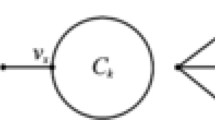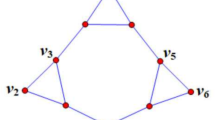Abstract
Albertson [2] has introduced the imbalance of an edge e=uv in a graph G as |d
G
(u)−d
G
(v)|. If for a graph G of order n and size m the minimum imbalance of an edge of G equals d, then our main result states that  with equality if and only if G is isomorphic to
with equality if and only if G is isomorphic to  We also prove best-possible upper bounds on the number of edges uv of a graph G such that |d
G
(u)−d
G
(v)|≥d for some given d.
We also prove best-possible upper bounds on the number of edges uv of a graph G such that |d
G
(u)−d
G
(v)|≥d for some given d.
Similar content being viewed by others
References
Alavi, Y., Chartrand, G., Chung, F.R.K., Erdős, P., Graham, R.L., Oellermann, O.R.: Highly irregular graphs. J. Graph Theory 11, 235–249 (1987)
Albertson, M.O.: The irregularity of a graph. Ars Combinatoria 46, 219–225 (1997)
Bell, F.K.: A note on the irregularity of graphs. Linear Algebra Appl. 161, 45–54 (1992)
Caro, Y., Yuster, R.: Graphs with large variance. Ars Combinatoria 57, 151–162 (2000)
Henning, M., Rautenbach, D.: On the Irregularity of Bipartite Graphs, to appear in Discrete Math.
Rautenbach, D.: Propagation of mean degrees. Electr. J. Combin. 11, N11 (2004)
Rautenbach, D., Volkmann, L.: How local irregularity gets global in a graph. J. Graph Theory 41, 18–23 (2002)
Author information
Authors and Affiliations
Corresponding author
Rights and permissions
About this article
Cite this article
Rautenbach, D., Schiermeyer, I. Extremal Problems for Imbalanced Edges. Graphs and Combinatorics 22, 103–111 (2006). https://doi.org/10.1007/s00373-005-0643-y
Received:
Accepted:
Issue Date:
DOI: https://doi.org/10.1007/s00373-005-0643-y




